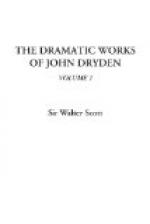Thus, while Dryden’s style resembled that of Juvenal rather than Horace, he may claim a superiority, for uniform and undeviating dignity, over the Roman satirist. The age, whose appetite for scandal had been profusely fed by lampoons and libels, now learned, that there was a more elevated kind of satire, in which poignancy might be united with elegance, and energy of thought with harmony of versification. The example seems to have produced a strong effect. No poet, not even Settle (for even the worst artist will improve from beholding a masterpiece), afterwards conceived he had sufficiently accomplished his task by presenting to the public, thoughts, however witty or caustic he might deem them, clothed in the hobbling measure of Donne or Cleveland; and expression and harmony began to be consulted, in satire, as well as sarcastic humour or powerful illustration.
“Mac-Flecknoe,” in some degree, differs from the other satires which Dryden published at this time. It is not confined to the description of character, but exhibits an imaginary course of incidents, in which the principal personage takes a ludicrous share. In this it resembles “Hudibras;” and both are quoted by Dryden himself as examples of the Varronian satire. But there was this pointed difference, that Butler’s poem is burlesque, and Dryden’s mock-heroic. “Mac-Flecknoe” is, I rather believe, the first poem in the English language, in which the dignity of a harmonised and lofty style is employed, not only to excite pleasure in itself, but to increase, by contrast, the comic effect of the scenes which it narrates; the subject being ludicrous, while the verse is noble. The models of satire afforded by Dryden, as they have never been equalled by any succeeding poet, were in a tone of excellence superior far to all that had preceded them.
These reflections on the nature of Dryden’s satires, have, in some degree, interrupted our account of his political controversies. Not only did he pour forth these works, one after another, with a fertility which seemed to imply delight in his new labour; but, as if the spirit of the time had taught him speed, he found leisure to oppose the Whigs in the theatre, where the audience was now nearly as much divided as the kingdom by the contending factions. Settle had produced the tragedy of “Pope Joan,” Shadwell the comedy of the “Lancashire Witches,” to expose to hatred and ridicule the religion of the successor to the crown. Otway and D’Urfey, Crowne and Southerne, names unequal in fame, vied in producing plays against the Whigs, which might counterbalance the effect of these popular dramas. A licence similar to that of Aristophanes was introduced on the English stage; and living personages were exhibited under very slight disguises.[32] In the prologues and epilogues, which then served as a sort of moral to the plays, the veil, thin as it was, was completely raised, and the political analogies pointed out to such of the audience as might otherwise have been




